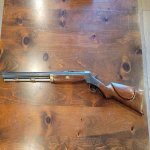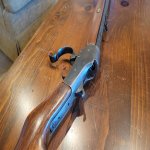relayer1989
CGN Regular
- Location
- Belleville, Ontario
This past weekend I picked up a unique 45 Cal muzzleloader from the Belleville Gun Show.
It appears to be an Investarms Hawken barrel and stock fitted to a Hopkins & Allen falling block shotgun.
Is this build something that was done? Or is this a one off?
A custom breech plug was made to use with 209 primers.
One issue is that the breech plug is completely open, which means the powder would lead right up to the primer. It also means you have to load with a spent primer in place otherwise powder would spill out, and then swap to live primer before firing. Thinking I might try to create a new breech plug with a proper flash hole.


It appears to be an Investarms Hawken barrel and stock fitted to a Hopkins & Allen falling block shotgun.
Is this build something that was done? Or is this a one off?
A custom breech plug was made to use with 209 primers.
One issue is that the breech plug is completely open, which means the powder would lead right up to the primer. It also means you have to load with a spent primer in place otherwise powder would spill out, and then swap to live primer before firing. Thinking I might try to create a new breech plug with a proper flash hole.










































































